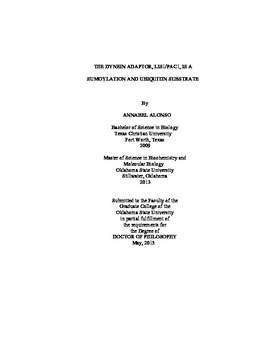| dc.contributor.advisor | Miller, Rita K. | |
| dc.contributor.author | Alonso, Annabel | |
| dc.date.accessioned | 2016-09-29T18:31:01Z | |
| dc.date.available | 2016-09-29T18:31:01Z | |
| dc.date.issued | 2015-05 | |
| dc.identifier.uri | https://hdl.handle.net/11244/45131 | |
| dc.description.abstract | Microtubules are proteinaceous that contribute to cell motility and cell division. Microtubules are highly dynamic, continuously growing and shrinking. Because microtubules are fundamental for cell division, it is important to understand the molecular mechanisms that regulate them. Pac1p, the Lis1 homologue in yeast, is a microtubule plus-end-tracking protein. Mutations in the LIS1 gene have been correlated with Miller-Dieker Lissencephaly syndrome due to defects in neuronal migration. Spindle positioning in yeast is an essential process during cell division that is regulated by the KAR9 and dynein pathways. The KAR9 pathway guides cytoplasmic microtubules into the bud. Dynein pulls the spindle across the bud neck via the forces it exerts on the cytoplasmic microtubule from the cortex. As part of the dynein pathway, Pac1p is important for recruiting dynein to the plus end of the microtubule and regulates its motility. Pac1p interacts with other plus-end microtubule binding proteins including Bik1p, the CLIP-170 homologue in yeast. Although Pac1p plays vital roles for microtubule function, little is known about its regulation. | |
| dc.description.abstract | Sumoylation is a post-translational modification that covalently attaches a Small Ubiquitin-like Modifier (SUMO) protein to the target substrate. Using a two-hybrid assay, Pac1p interacts with SMT3, the SUMO homologue in yeast, and other key players of the sumoylation pathway. Ubiquitin-like-specific protease-1 (Ulp1) is a protease that specifically cleaves Smt3p from its protein conjugates. Using a temperature sensitive strain that inactivates the Ulp1p protease, we observe an accumulation of higher molecular weight Pac1p bands. This suggests that the higher molecular weight forms of Pac1p are due to the accumulation of SMT3 conjugates. In contrast to ubiquitination, sumoylation is not a modification that tags the target substrate for direct degradation. However, SUMO-targeted ubiquitin ligases (STUbLs) can recognize a sumoylated substrate and promote its degradation of the substrate via ubiquitination. Using a two-hybrid assay, we show that Pac1p interacts with the STUbL enzyme Nis1p/Ris1p. Pac1p also co-purified with ubiquitin. Strains deleted for RIS1 and the SUMO isopeptidase WSS1, display an accumulation of higher molecular weight Pac1p conjugates, in comparison to WT. This work suggests a novel molecular mechanism of regulation for a microtubule-associated protein that regulates a critical microtubule motor. | |
| dc.format | application/pdf | |
| dc.language | en_US | |
| dc.rights | Copyright is held by the author who has granted the Oklahoma State University Library the non-exclusive right to share this material in its institutional repository. Contact Digital Library Services at lib-dls@okstate.edu or 405-744-9161 for the permission policy on the use, reproduction or distribution of this material. | |
| dc.title | Dynein adaptor, Lis1/Pac1, is a sumoylation and ubiquitin substrate | |
| dc.contributor.committeeMember | Hartson, Steve | |
| dc.contributor.committeeMember | Hernandez Gifford, Jennifer | |
| dc.contributor.committeeMember | Deng, Junpeng | |
| dc.contributor.committeeMember | Mort, Andrew | |
| osu.filename | Alonso_okstate_0664D_13971.pdf | |
| osu.accesstype | Open Access | |
| dc.type.genre | Dissertation | |
| dc.type.material | Text | |
| thesis.degree.discipline | Biochemistry and Molecular Biology | |
| thesis.degree.grantor | Oklahoma State University | |
